Proctor & Gamble (P&G) Strategy and Analysis: A Detailed Report
VerifiedAdded on 2020/01/07
|21
|7729
|85
Report
AI Summary
This report provides a strategic analysis of Proctor & Gamble (P&G), examining its external environment through PESTEL analysis and market structure, and assessing its competitive position using Porter's Five Forces. The report identifies key success factors and explores P&G's internal environment, including resources and capabilities. It highlights the company's competitive advantages, such as cost leadership and differentiation. Strategic recommendations are also provided, addressing stakeholder management. The analysis includes discussions on P&G's open innovation strategy, its strengths, weaknesses, opportunities, and threats (SWOT), and its resource management. The report aims to offer a comprehensive understanding of P&G's strategic approach and its position within the consumer goods market, although some sections are incomplete. The executive summary and vision and objectives are missing.
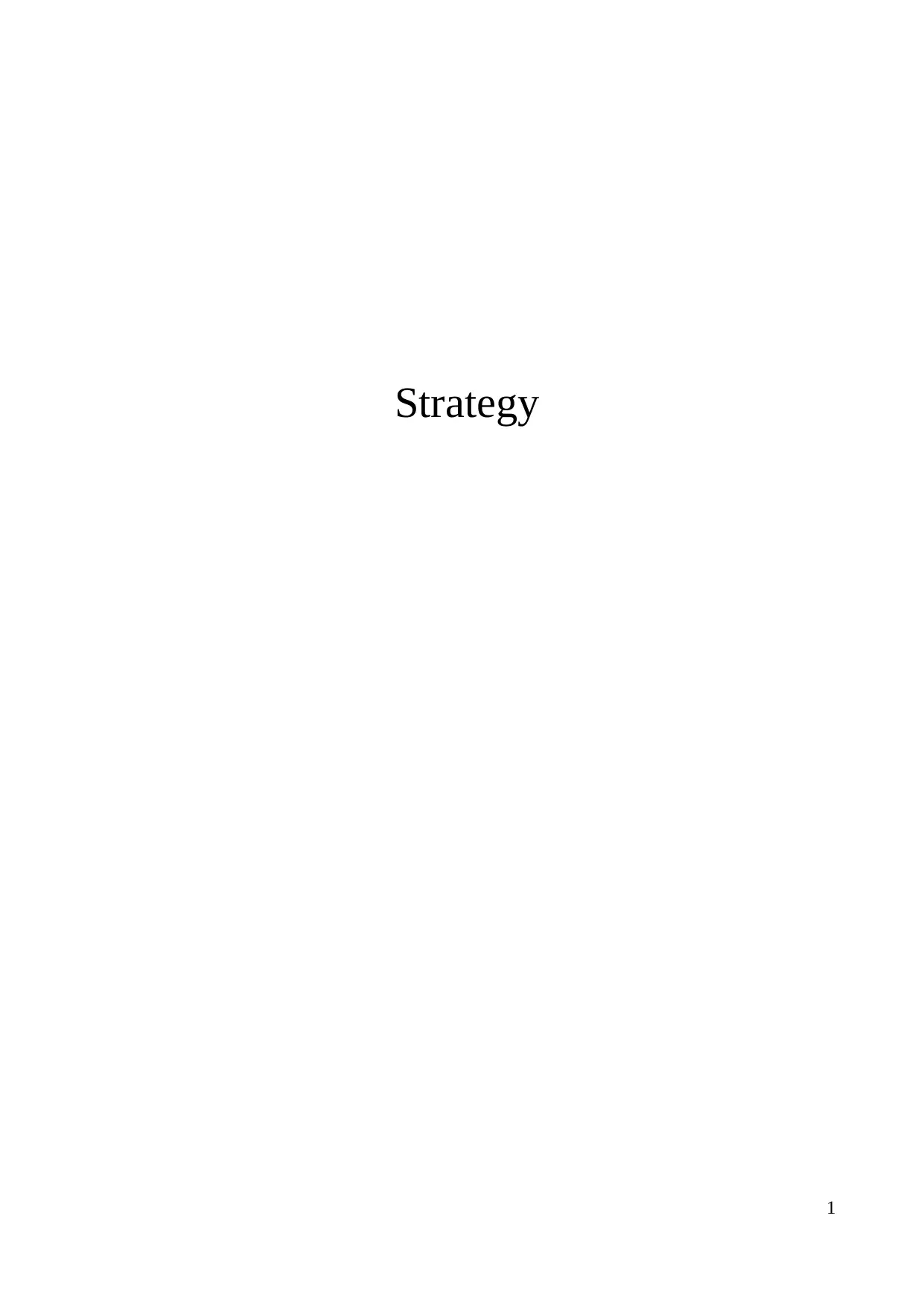
Strategy
1
1
Paraphrase This Document
Need a fresh take? Get an instant paraphrase of this document with our AI Paraphraser

Table of Contents
INTRODUCTION ...............................................................................................................................3
External environment...........................................................................................................................3
PESTEL Analysis.............................................................................................................................3
Market Structure..............................................................................................................................4
Five Forces.......................................................................................................................................4
Key Success Factors........................................................................................................................5
Internal environment............................................................................................................................5
Resources.........................................................................................................................................5
Intangible Resources........................................................................................................................5
Tangible Resources..........................................................................................................................6
Human Resources............................................................................................................................6
Capabilities......................................................................................................................................7
Value Chain Analysis ......................................................................................................................8
Functional Analysis .........................................................................................................................9
Competitive Advantages.......................................................................................................................9
Cost Leadership...............................................................................................................................9
Differentiation Advantages............................................................................................................10
Strategic Recommendations...............................................................................................................10
Stakeholder Management...................................................................................................................11
CONCLUSION...................................................................................................................................11
References..........................................................................................................................................12
2
INTRODUCTION ...............................................................................................................................3
External environment...........................................................................................................................3
PESTEL Analysis.............................................................................................................................3
Market Structure..............................................................................................................................4
Five Forces.......................................................................................................................................4
Key Success Factors........................................................................................................................5
Internal environment............................................................................................................................5
Resources.........................................................................................................................................5
Intangible Resources........................................................................................................................5
Tangible Resources..........................................................................................................................6
Human Resources............................................................................................................................6
Capabilities......................................................................................................................................7
Value Chain Analysis ......................................................................................................................8
Functional Analysis .........................................................................................................................9
Competitive Advantages.......................................................................................................................9
Cost Leadership...............................................................................................................................9
Differentiation Advantages............................................................................................................10
Strategic Recommendations...............................................................................................................10
Stakeholder Management...................................................................................................................11
CONCLUSION...................................................................................................................................11
References..........................................................................................................................................12
2

3
⊘ This is a preview!⊘
Do you want full access?
Subscribe today to unlock all pages.

Trusted by 1+ million students worldwide

4
Paraphrase This Document
Need a fresh take? Get an instant paraphrase of this document with our AI Paraphraser

MISSING EXECUTIVE SUMARY
EXECUTIVE SUMMARY
Proctor & Gamble (P&G) is a Fortune 500 American multinational company which is
involved in functional activity of manufacturing and selling personal health care products to
its consumers. Open innovation strategy method has helped the company to stay ahead
with its competitors by making superior quality product at relatively lower cost. Company
uses product and service innovation methods to differ its product from other goods
available in market. Method of strategy innovation has been recommended for company to
improve its performance by developing its operational and promotional activities in a better
way. Cost differentiation strategy has helped the firm to reach middle class and lower class
consumer segments by reducing price of its products. It has reduced its overall investment
cost by adopting innovative technology and methods to achieve objective of this strategy.
The approach of P&G group to expand its market in global areas has proved beneficial for
the firm and it has increased capital structure and revenue of the firm.
INTRODUCTION
Nowadays, the game-changing part of an organisation is its level of innovations. It not
only related to products and services but also include the ability to convert ideas into
new offerings. Those elements which make an individual to develop innovative
products and services include business strategy, great talent, deep customer insight,
proper knowledge of roles, responsibilities, etc. Along with this, it is also important to
have an active corporate culture which can support their innovation strategies (Oke,
Walumbwa and Myers, 2012).
For the present study, Procter & Gamble (P&G) is taken into the consideration, an
American multinational consumer goods firm, which offers a range of different
products for its customers. These consists of cleaning agents and personal care
products like Gillette, Ariel, Oral-B, Always, Fairy, Head & Shoulders, and much more.
The company has worked hard for including innovations into its daily routine and
organisational culture. Company uses open strategy which allows firms to use external
ideas and internal ideas to improve productivity and overall performance of the firm.
Open innovation strategy is concept which provides guidelines for using external
research data by sourcing it from other comapnies or by buying patents from other
business house. It helps in reducing cost of conducting research and development and
increases accuracy of company for doing market research and data analysis.
The file includes innovation strategy concerning the cited firm utilizing an
internal/external analysis and market structure. Along with this, it also consists of
stakeholder management.
NEED TO EXPLAIN MORE ABOUT OPEN INNOVATION STRATEGY (C+D)
EXTERNAL ENVIRONMENT
PESTEL Analysis
The PESTEL for P&G is as follows:
• Political Factors: According to the Rowley, (2011), Changes in either foreign or local
activities in the field of politics affects the working of organisations. It is important for
firms to develop effective strategies for handling political changes. In context to this,
P&G uses its goodwill and experiences for bargaining with the government of different
5
EXECUTIVE SUMMARY
Proctor & Gamble (P&G) is a Fortune 500 American multinational company which is
involved in functional activity of manufacturing and selling personal health care products to
its consumers. Open innovation strategy method has helped the company to stay ahead
with its competitors by making superior quality product at relatively lower cost. Company
uses product and service innovation methods to differ its product from other goods
available in market. Method of strategy innovation has been recommended for company to
improve its performance by developing its operational and promotional activities in a better
way. Cost differentiation strategy has helped the firm to reach middle class and lower class
consumer segments by reducing price of its products. It has reduced its overall investment
cost by adopting innovative technology and methods to achieve objective of this strategy.
The approach of P&G group to expand its market in global areas has proved beneficial for
the firm and it has increased capital structure and revenue of the firm.
INTRODUCTION
Nowadays, the game-changing part of an organisation is its level of innovations. It not
only related to products and services but also include the ability to convert ideas into
new offerings. Those elements which make an individual to develop innovative
products and services include business strategy, great talent, deep customer insight,
proper knowledge of roles, responsibilities, etc. Along with this, it is also important to
have an active corporate culture which can support their innovation strategies (Oke,
Walumbwa and Myers, 2012).
For the present study, Procter & Gamble (P&G) is taken into the consideration, an
American multinational consumer goods firm, which offers a range of different
products for its customers. These consists of cleaning agents and personal care
products like Gillette, Ariel, Oral-B, Always, Fairy, Head & Shoulders, and much more.
The company has worked hard for including innovations into its daily routine and
organisational culture. Company uses open strategy which allows firms to use external
ideas and internal ideas to improve productivity and overall performance of the firm.
Open innovation strategy is concept which provides guidelines for using external
research data by sourcing it from other comapnies or by buying patents from other
business house. It helps in reducing cost of conducting research and development and
increases accuracy of company for doing market research and data analysis.
The file includes innovation strategy concerning the cited firm utilizing an
internal/external analysis and market structure. Along with this, it also consists of
stakeholder management.
NEED TO EXPLAIN MORE ABOUT OPEN INNOVATION STRATEGY (C+D)
EXTERNAL ENVIRONMENT
PESTEL Analysis
The PESTEL for P&G is as follows:
• Political Factors: According to the Rowley, (2011), Changes in either foreign or local
activities in the field of politics affects the working of organisations. It is important for
firms to develop effective strategies for handling political changes. In context to this,
P&G uses its goodwill and experiences for bargaining with the government of different
5
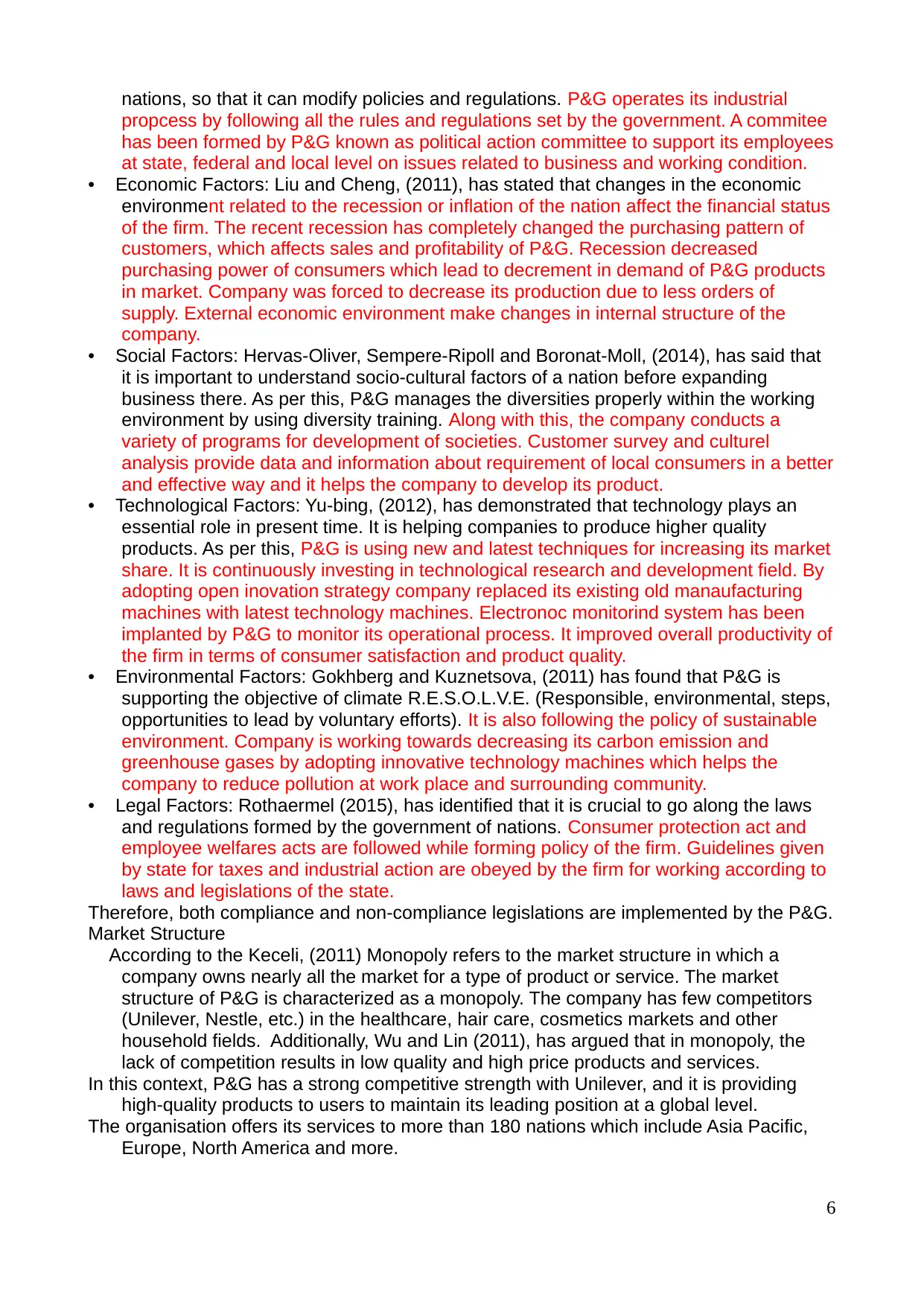
nations, so that it can modify policies and regulations. P&G operates its industrial
propcess by following all the rules and regulations set by the government. A commitee
has been formed by P&G known as political action committee to support its employees
at state, federal and local level on issues related to business and working condition.
• Economic Factors: Liu and Cheng, (2011), has stated that changes in the economic
environment related to the recession or inflation of the nation affect the financial status
of the firm. The recent recession has completely changed the purchasing pattern of
customers, which affects sales and profitability of P&G. Recession decreased
purchasing power of consumers which lead to decrement in demand of P&G products
in market. Company was forced to decrease its production due to less orders of
supply. External economic environment make changes in internal structure of the
company.
• Social Factors: Hervas-Oliver, Sempere-Ripoll and Boronat-Moll, (2014), has said that
it is important to understand socio-cultural factors of a nation before expanding
business there. As per this, P&G manages the diversities properly within the working
environment by using diversity training. Along with this, the company conducts a
variety of programs for development of societies. Customer survey and culturel
analysis provide data and information about requirement of local consumers in a better
and effective way and it helps the company to develop its product.
• Technological Factors: Yu-bing, (2012), has demonstrated that technology plays an
essential role in present time. It is helping companies to produce higher quality
products. As per this, P&G is using new and latest techniques for increasing its market
share. It is continuously investing in technological research and development field. By
adopting open inovation strategy company replaced its existing old manaufacturing
machines with latest technology machines. Electronoc monitorind system has been
implanted by P&G to monitor its operational process. It improved overall productivity of
the firm in terms of consumer satisfaction and product quality.
• Environmental Factors: Gokhberg and Kuznetsova, (2011) has found that P&G is
supporting the objective of climate R.E.S.O.L.V.E. (Responsible, environmental, steps,
opportunities to lead by voluntary efforts). It is also following the policy of sustainable
environment. Company is working towards decreasing its carbon emission and
greenhouse gases by adopting innovative technology machines which helps the
company to reduce pollution at work place and surrounding community.
• Legal Factors: Rothaermel (2015), has identified that it is crucial to go along the laws
and regulations formed by the government of nations. Consumer protection act and
employee welfares acts are followed while forming policy of the firm. Guidelines given
by state for taxes and industrial action are obeyed by the firm for working according to
laws and legislations of the state.
Therefore, both compliance and non-compliance legislations are implemented by the P&G.
Market Structure
According to the Keceli, (2011) Monopoly refers to the market structure in which a
company owns nearly all the market for a type of product or service. The market
structure of P&G is characterized as a monopoly. The company has few competitors
(Unilever, Nestle, etc.) in the healthcare, hair care, cosmetics markets and other
household fields. Additionally, Wu and Lin (2011), has argued that in monopoly, the
lack of competition results in low quality and high price products and services.
In this context, P&G has a strong competitive strength with Unilever, and it is providing
high-quality products to users to maintain its leading position at a global level.
The organisation offers its services to more than 180 nations which include Asia Pacific,
Europe, North America and more.
6
propcess by following all the rules and regulations set by the government. A commitee
has been formed by P&G known as political action committee to support its employees
at state, federal and local level on issues related to business and working condition.
• Economic Factors: Liu and Cheng, (2011), has stated that changes in the economic
environment related to the recession or inflation of the nation affect the financial status
of the firm. The recent recession has completely changed the purchasing pattern of
customers, which affects sales and profitability of P&G. Recession decreased
purchasing power of consumers which lead to decrement in demand of P&G products
in market. Company was forced to decrease its production due to less orders of
supply. External economic environment make changes in internal structure of the
company.
• Social Factors: Hervas-Oliver, Sempere-Ripoll and Boronat-Moll, (2014), has said that
it is important to understand socio-cultural factors of a nation before expanding
business there. As per this, P&G manages the diversities properly within the working
environment by using diversity training. Along with this, the company conducts a
variety of programs for development of societies. Customer survey and culturel
analysis provide data and information about requirement of local consumers in a better
and effective way and it helps the company to develop its product.
• Technological Factors: Yu-bing, (2012), has demonstrated that technology plays an
essential role in present time. It is helping companies to produce higher quality
products. As per this, P&G is using new and latest techniques for increasing its market
share. It is continuously investing in technological research and development field. By
adopting open inovation strategy company replaced its existing old manaufacturing
machines with latest technology machines. Electronoc monitorind system has been
implanted by P&G to monitor its operational process. It improved overall productivity of
the firm in terms of consumer satisfaction and product quality.
• Environmental Factors: Gokhberg and Kuznetsova, (2011) has found that P&G is
supporting the objective of climate R.E.S.O.L.V.E. (Responsible, environmental, steps,
opportunities to lead by voluntary efforts). It is also following the policy of sustainable
environment. Company is working towards decreasing its carbon emission and
greenhouse gases by adopting innovative technology machines which helps the
company to reduce pollution at work place and surrounding community.
• Legal Factors: Rothaermel (2015), has identified that it is crucial to go along the laws
and regulations formed by the government of nations. Consumer protection act and
employee welfares acts are followed while forming policy of the firm. Guidelines given
by state for taxes and industrial action are obeyed by the firm for working according to
laws and legislations of the state.
Therefore, both compliance and non-compliance legislations are implemented by the P&G.
Market Structure
According to the Keceli, (2011) Monopoly refers to the market structure in which a
company owns nearly all the market for a type of product or service. The market
structure of P&G is characterized as a monopoly. The company has few competitors
(Unilever, Nestle, etc.) in the healthcare, hair care, cosmetics markets and other
household fields. Additionally, Wu and Lin (2011), has argued that in monopoly, the
lack of competition results in low quality and high price products and services.
In this context, P&G has a strong competitive strength with Unilever, and it is providing
high-quality products to users to maintain its leading position at a global level.
The organisation offers its services to more than 180 nations which include Asia Pacific,
Europe, North America and more.
6
⊘ This is a preview!⊘
Do you want full access?
Subscribe today to unlock all pages.

Trusted by 1+ million students worldwide
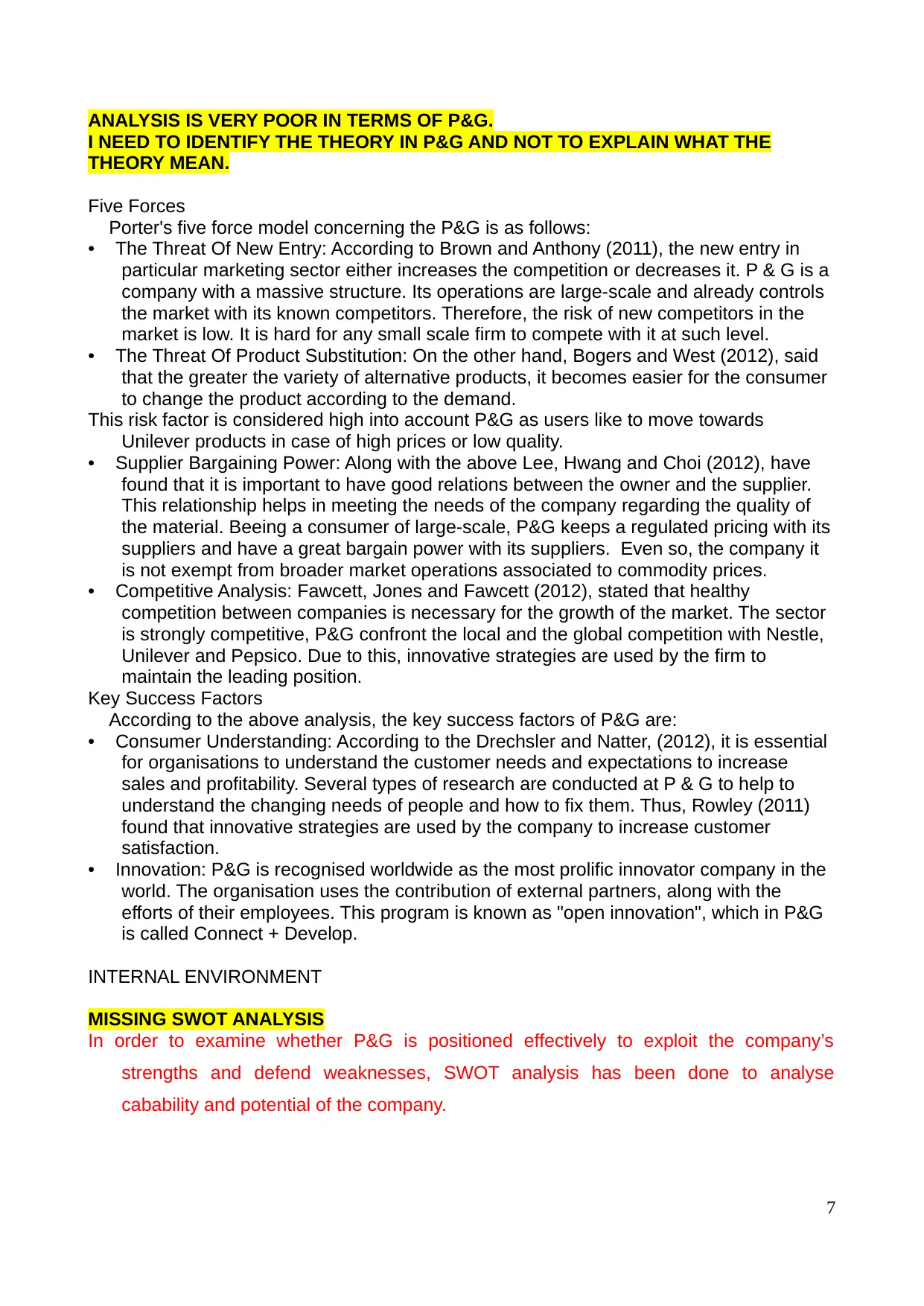
ANALYSIS IS VERY POOR IN TERMS OF P&G.
I NEED TO IDENTIFY THE THEORY IN P&G AND NOT TO EXPLAIN WHAT THE
THEORY MEAN.
Five Forces
Porter's five force model concerning the P&G is as follows:
• The Threat Of New Entry: According to Brown and Anthony (2011), the new entry in
particular marketing sector either increases the competition or decreases it. P & G is a
company with a massive structure. Its operations are large-scale and already controls
the market with its known competitors. Therefore, the risk of new competitors in the
market is low. It is hard for any small scale firm to compete with it at such level.
• The Threat Of Product Substitution: On the other hand, Bogers and West (2012), said
that the greater the variety of alternative products, it becomes easier for the consumer
to change the product according to the demand.
This risk factor is considered high into account P&G as users like to move towards
Unilever products in case of high prices or low quality.
• Supplier Bargaining Power: Along with the above Lee, Hwang and Choi (2012), have
found that it is important to have good relations between the owner and the supplier.
This relationship helps in meeting the needs of the company regarding the quality of
the material. Beeing a consumer of large-scale, P&G keeps a regulated pricing with its
suppliers and have a great bargain power with its suppliers. Even so, the company it
is not exempt from broader market operations associated to commodity prices.
• Competitive Analysis: Fawcett, Jones and Fawcett (2012), stated that healthy
competition between companies is necessary for the growth of the market. The sector
is strongly competitive, P&G confront the local and the global competition with Nestle,
Unilever and Pepsico. Due to this, innovative strategies are used by the firm to
maintain the leading position.
Key Success Factors
According to the above analysis, the key success factors of P&G are:
• Consumer Understanding: According to the Drechsler and Natter, (2012), it is essential
for organisations to understand the customer needs and expectations to increase
sales and profitability. Several types of research are conducted at P & G to help to
understand the changing needs of people and how to fix them. Thus, Rowley (2011)
found that innovative strategies are used by the company to increase customer
satisfaction.
• Innovation: P&G is recognised worldwide as the most prolific innovator company in the
world. The organisation uses the contribution of external partners, along with the
efforts of their employees. This program is known as "open innovation", which in P&G
is called Connect + Develop.
INTERNAL ENVIRONMENT
MISSING SWOT ANALYSIS
In order to examine whether P&G is positioned effectively to exploit the company’s
strengths and defend weaknesses, SWOT analysis has been done to analyse
cabability and potential of the company.
7
I NEED TO IDENTIFY THE THEORY IN P&G AND NOT TO EXPLAIN WHAT THE
THEORY MEAN.
Five Forces
Porter's five force model concerning the P&G is as follows:
• The Threat Of New Entry: According to Brown and Anthony (2011), the new entry in
particular marketing sector either increases the competition or decreases it. P & G is a
company with a massive structure. Its operations are large-scale and already controls
the market with its known competitors. Therefore, the risk of new competitors in the
market is low. It is hard for any small scale firm to compete with it at such level.
• The Threat Of Product Substitution: On the other hand, Bogers and West (2012), said
that the greater the variety of alternative products, it becomes easier for the consumer
to change the product according to the demand.
This risk factor is considered high into account P&G as users like to move towards
Unilever products in case of high prices or low quality.
• Supplier Bargaining Power: Along with the above Lee, Hwang and Choi (2012), have
found that it is important to have good relations between the owner and the supplier.
This relationship helps in meeting the needs of the company regarding the quality of
the material. Beeing a consumer of large-scale, P&G keeps a regulated pricing with its
suppliers and have a great bargain power with its suppliers. Even so, the company it
is not exempt from broader market operations associated to commodity prices.
• Competitive Analysis: Fawcett, Jones and Fawcett (2012), stated that healthy
competition between companies is necessary for the growth of the market. The sector
is strongly competitive, P&G confront the local and the global competition with Nestle,
Unilever and Pepsico. Due to this, innovative strategies are used by the firm to
maintain the leading position.
Key Success Factors
According to the above analysis, the key success factors of P&G are:
• Consumer Understanding: According to the Drechsler and Natter, (2012), it is essential
for organisations to understand the customer needs and expectations to increase
sales and profitability. Several types of research are conducted at P & G to help to
understand the changing needs of people and how to fix them. Thus, Rowley (2011)
found that innovative strategies are used by the company to increase customer
satisfaction.
• Innovation: P&G is recognised worldwide as the most prolific innovator company in the
world. The organisation uses the contribution of external partners, along with the
efforts of their employees. This program is known as "open innovation", which in P&G
is called Connect + Develop.
INTERNAL ENVIRONMENT
MISSING SWOT ANALYSIS
In order to examine whether P&G is positioned effectively to exploit the company’s
strengths and defend weaknesses, SWOT analysis has been done to analyse
cabability and potential of the company.
7
Paraphrase This Document
Need a fresh take? Get an instant paraphrase of this document with our AI Paraphraser
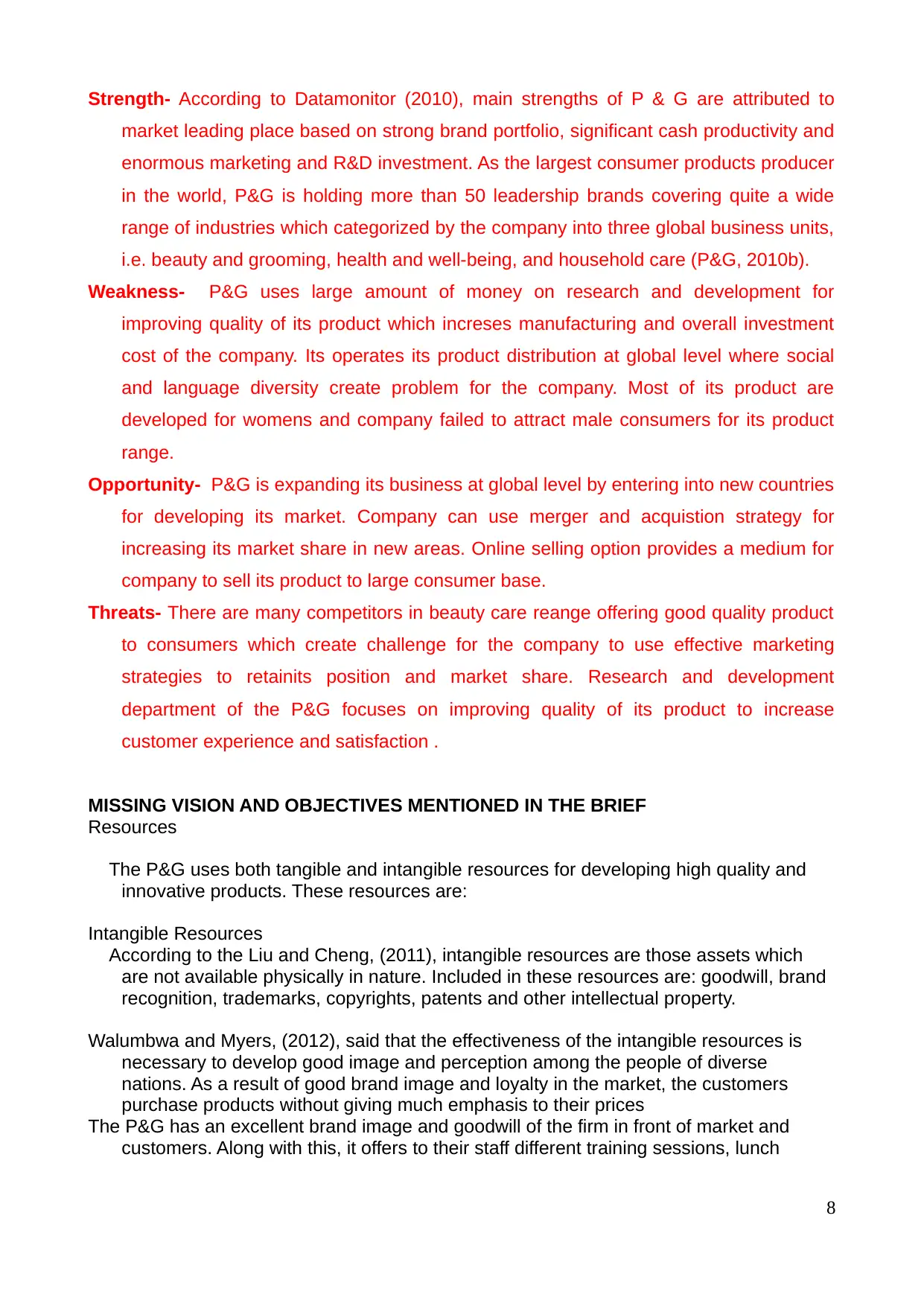
Strength- According to Datamonitor (2010), main strengths of P & G are attributed to
market leading place based on strong brand portfolio, significant cash productivity and
enormous marketing and R&D investment. As the largest consumer products producer
in the world, P&G is holding more than 50 leadership brands covering quite a wide
range of industries which categorized by the company into three global business units,
i.e. beauty and grooming, health and well-being, and household care (P&G, 2010b).
Weakness- P&G uses large amount of money on research and development for
improving quality of its product which increses manufacturing and overall investment
cost of the company. Its operates its product distribution at global level where social
and language diversity create problem for the company. Most of its product are
developed for womens and company failed to attract male consumers for its product
range.
Opportunity- P&G is expanding its business at global level by entering into new countries
for developing its market. Company can use merger and acquistion strategy for
increasing its market share in new areas. Online selling option provides a medium for
company to sell its product to large consumer base.
Threats- There are many competitors in beauty care reange offering good quality product
to consumers which create challenge for the company to use effective marketing
strategies to retainits position and market share. Research and development
department of the P&G focuses on improving quality of its product to increase
customer experience and satisfaction .
MISSING VISION AND OBJECTIVES MENTIONED IN THE BRIEF
Resources
The P&G uses both tangible and intangible resources for developing high quality and
innovative products. These resources are:
Intangible Resources
According to the Liu and Cheng, (2011), intangible resources are those assets which
are not available physically in nature. Included in these resources are: goodwill, brand
recognition, trademarks, copyrights, patents and other intellectual property.
Walumbwa and Myers, (2012), said that the effectiveness of the intangible resources is
necessary to develop good image and perception among the people of diverse
nations. As a result of good brand image and loyalty in the market, the customers
purchase products without giving much emphasis to their prices
The P&G has an excellent brand image and goodwill of the firm in front of market and
customers. Along with this, it offers to their staff different training sessions, lunch
8
market leading place based on strong brand portfolio, significant cash productivity and
enormous marketing and R&D investment. As the largest consumer products producer
in the world, P&G is holding more than 50 leadership brands covering quite a wide
range of industries which categorized by the company into three global business units,
i.e. beauty and grooming, health and well-being, and household care (P&G, 2010b).
Weakness- P&G uses large amount of money on research and development for
improving quality of its product which increses manufacturing and overall investment
cost of the company. Its operates its product distribution at global level where social
and language diversity create problem for the company. Most of its product are
developed for womens and company failed to attract male consumers for its product
range.
Opportunity- P&G is expanding its business at global level by entering into new countries
for developing its market. Company can use merger and acquistion strategy for
increasing its market share in new areas. Online selling option provides a medium for
company to sell its product to large consumer base.
Threats- There are many competitors in beauty care reange offering good quality product
to consumers which create challenge for the company to use effective marketing
strategies to retainits position and market share. Research and development
department of the P&G focuses on improving quality of its product to increase
customer experience and satisfaction .
MISSING VISION AND OBJECTIVES MENTIONED IN THE BRIEF
Resources
The P&G uses both tangible and intangible resources for developing high quality and
innovative products. These resources are:
Intangible Resources
According to the Liu and Cheng, (2011), intangible resources are those assets which
are not available physically in nature. Included in these resources are: goodwill, brand
recognition, trademarks, copyrights, patents and other intellectual property.
Walumbwa and Myers, (2012), said that the effectiveness of the intangible resources is
necessary to develop good image and perception among the people of diverse
nations. As a result of good brand image and loyalty in the market, the customers
purchase products without giving much emphasis to their prices
The P&G has an excellent brand image and goodwill of the firm in front of market and
customers. Along with this, it offers to their staff different training sessions, lunch
8
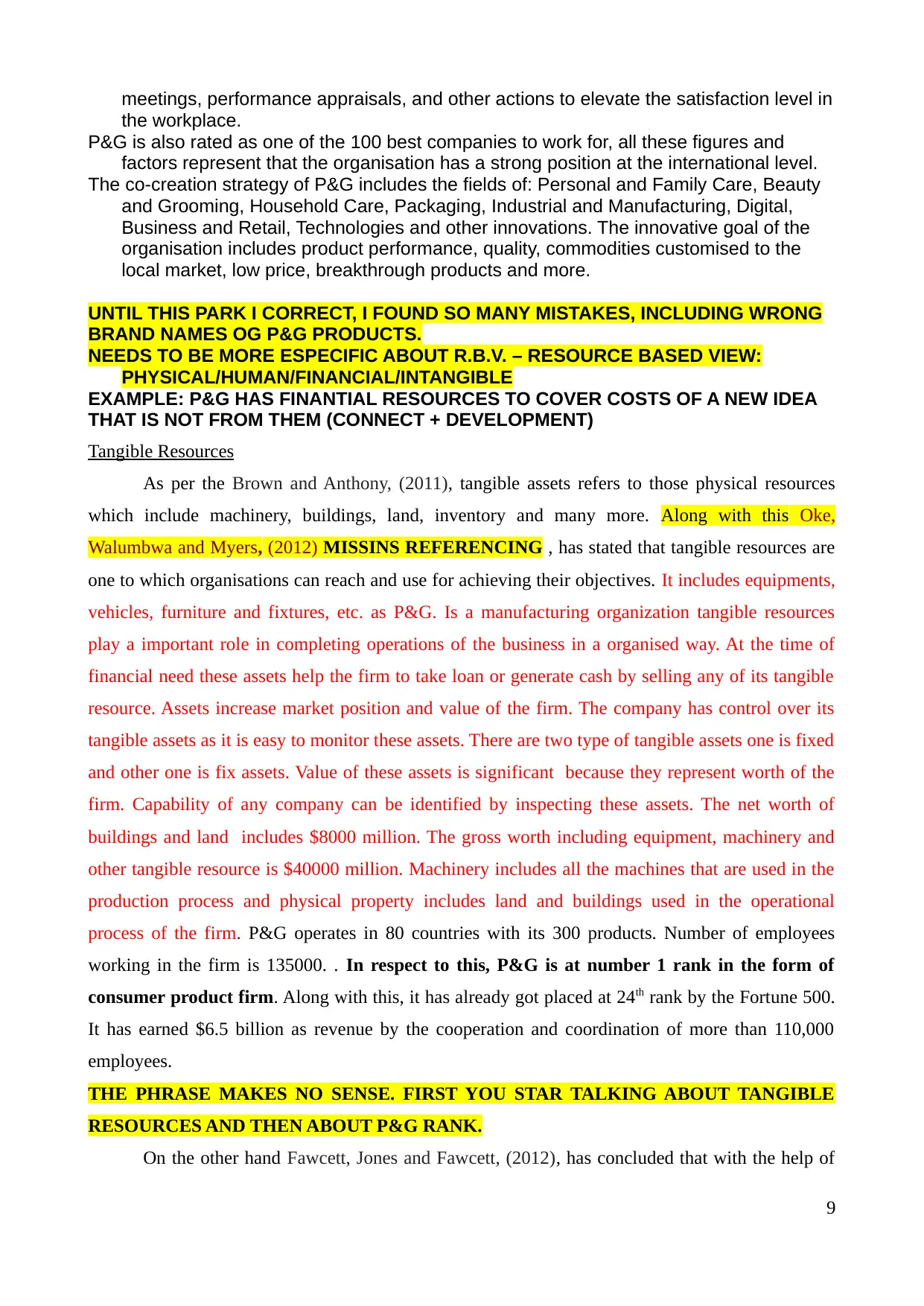
meetings, performance appraisals, and other actions to elevate the satisfaction level in
the workplace.
P&G is also rated as one of the 100 best companies to work for, all these figures and
factors represent that the organisation has a strong position at the international level.
The co-creation strategy of P&G includes the fields of: Personal and Family Care, Beauty
and Grooming, Household Care, Packaging, Industrial and Manufacturing, Digital,
Business and Retail, Technologies and other innovations. The innovative goal of the
organisation includes product performance, quality, commodities customised to the
local market, low price, breakthrough products and more.
UNTIL THIS PARK I CORRECT, I FOUND SO MANY MISTAKES, INCLUDING WRONG
BRAND NAMES OG P&G PRODUCTS.
NEEDS TO BE MORE ESPECIFIC ABOUT R.B.V. – RESOURCE BASED VIEW:
PHYSICAL/HUMAN/FINANCIAL/INTANGIBLE
EXAMPLE: P&G HAS FINANTIAL RESOURCES TO COVER COSTS OF A NEW IDEA
THAT IS NOT FROM THEM (CONNECT + DEVELOPMENT)
Tangible Resources
As per the Brown and Anthony, (2011), tangible assets refers to those physical resources
which include machinery, buildings, land, inventory and many more. Along with this Oke,
Walumbwa and Myers, (2012) MISSINS REFERENCING , has stated that tangible resources are
one to which organisations can reach and use for achieving their objectives. It includes equipments,
vehicles, furniture and fixtures, etc. as P&G. Is a manufacturing organization tangible resources
play a important role in completing operations of the business in a organised way. At the time of
financial need these assets help the firm to take loan or generate cash by selling any of its tangible
resource. Assets increase market position and value of the firm. The company has control over its
tangible assets as it is easy to monitor these assets. There are two type of tangible assets one is fixed
and other one is fix assets. Value of these assets is significant because they represent worth of the
firm. Capability of any company can be identified by inspecting these assets. The net worth of
buildings and land includes $8000 million. The gross worth including equipment, machinery and
other tangible resource is $40000 million. Machinery includes all the machines that are used in the
production process and physical property includes land and buildings used in the operational
process of the firm. P&G operates in 80 countries with its 300 products. Number of employees
working in the firm is 135000. . In respect to this, P&G is at number 1 rank in the form of
consumer product firm. Along with this, it has already got placed at 24th rank by the Fortune 500.
It has earned $6.5 billion as revenue by the cooperation and coordination of more than 110,000
employees.
THE PHRASE MAKES NO SENSE. FIRST YOU STAR TALKING ABOUT TANGIBLE
RESOURCES AND THEN ABOUT P&G RANK.
On the other hand Fawcett, Jones and Fawcett, (2012), has concluded that with the help of
9
the workplace.
P&G is also rated as one of the 100 best companies to work for, all these figures and
factors represent that the organisation has a strong position at the international level.
The co-creation strategy of P&G includes the fields of: Personal and Family Care, Beauty
and Grooming, Household Care, Packaging, Industrial and Manufacturing, Digital,
Business and Retail, Technologies and other innovations. The innovative goal of the
organisation includes product performance, quality, commodities customised to the
local market, low price, breakthrough products and more.
UNTIL THIS PARK I CORRECT, I FOUND SO MANY MISTAKES, INCLUDING WRONG
BRAND NAMES OG P&G PRODUCTS.
NEEDS TO BE MORE ESPECIFIC ABOUT R.B.V. – RESOURCE BASED VIEW:
PHYSICAL/HUMAN/FINANCIAL/INTANGIBLE
EXAMPLE: P&G HAS FINANTIAL RESOURCES TO COVER COSTS OF A NEW IDEA
THAT IS NOT FROM THEM (CONNECT + DEVELOPMENT)
Tangible Resources
As per the Brown and Anthony, (2011), tangible assets refers to those physical resources
which include machinery, buildings, land, inventory and many more. Along with this Oke,
Walumbwa and Myers, (2012) MISSINS REFERENCING , has stated that tangible resources are
one to which organisations can reach and use for achieving their objectives. It includes equipments,
vehicles, furniture and fixtures, etc. as P&G. Is a manufacturing organization tangible resources
play a important role in completing operations of the business in a organised way. At the time of
financial need these assets help the firm to take loan or generate cash by selling any of its tangible
resource. Assets increase market position and value of the firm. The company has control over its
tangible assets as it is easy to monitor these assets. There are two type of tangible assets one is fixed
and other one is fix assets. Value of these assets is significant because they represent worth of the
firm. Capability of any company can be identified by inspecting these assets. The net worth of
buildings and land includes $8000 million. The gross worth including equipment, machinery and
other tangible resource is $40000 million. Machinery includes all the machines that are used in the
production process and physical property includes land and buildings used in the operational
process of the firm. P&G operates in 80 countries with its 300 products. Number of employees
working in the firm is 135000. . In respect to this, P&G is at number 1 rank in the form of
consumer product firm. Along with this, it has already got placed at 24th rank by the Fortune 500.
It has earned $6.5 billion as revenue by the cooperation and coordination of more than 110,000
employees.
THE PHRASE MAKES NO SENSE. FIRST YOU STAR TALKING ABOUT TANGIBLE
RESOURCES AND THEN ABOUT P&G RANK.
On the other hand Fawcett, Jones and Fawcett, (2012), has concluded that with the help of
9
⊘ This is a preview!⊘
Do you want full access?
Subscribe today to unlock all pages.

Trusted by 1+ million students worldwide
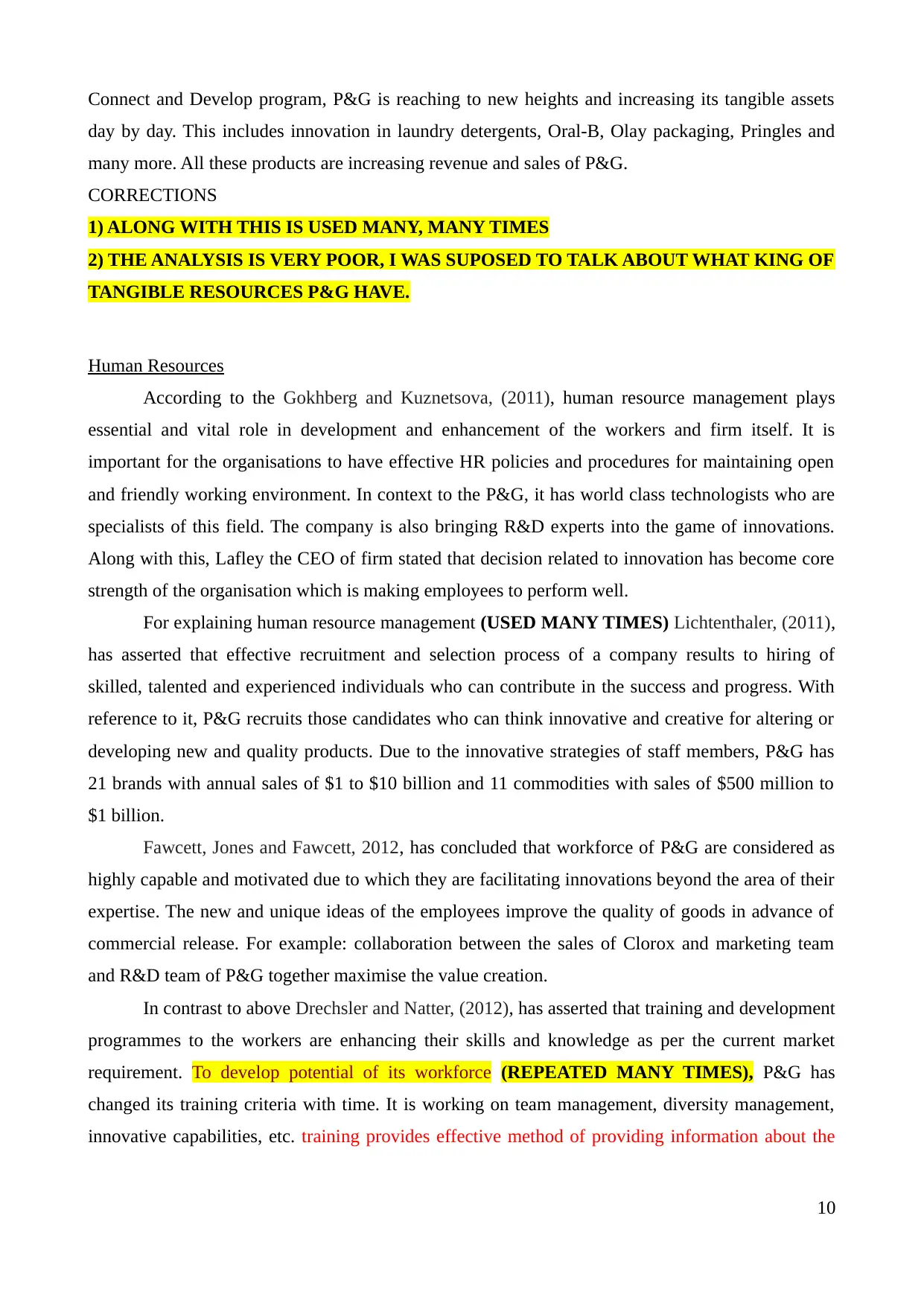
Connect and Develop program, P&G is reaching to new heights and increasing its tangible assets
day by day. This includes innovation in laundry detergents, Oral-B, Olay packaging, Pringles and
many more. All these products are increasing revenue and sales of P&G.
CORRECTIONS
1) ALONG WITH THIS IS USED MANY, MANY TIMES
2) THE ANALYSIS IS VERY POOR, I WAS SUPOSED TO TALK ABOUT WHAT KING OF
TANGIBLE RESOURCES P&G HAVE.
Human Resources
According to the Gokhberg and Kuznetsova, (2011), human resource management plays
essential and vital role in development and enhancement of the workers and firm itself. It is
important for the organisations to have effective HR policies and procedures for maintaining open
and friendly working environment. In context to the P&G, it has world class technologists who are
specialists of this field. The company is also bringing R&D experts into the game of innovations.
Along with this, Lafley the CEO of firm stated that decision related to innovation has become core
strength of the organisation which is making employees to perform well.
For explaining human resource management (USED MANY TIMES) Lichtenthaler, (2011),
has asserted that effective recruitment and selection process of a company results to hiring of
skilled, talented and experienced individuals who can contribute in the success and progress. With
reference to it, P&G recruits those candidates who can think innovative and creative for altering or
developing new and quality products. Due to the innovative strategies of staff members, P&G has
21 brands with annual sales of $1 to $10 billion and 11 commodities with sales of $500 million to
$1 billion.
Fawcett, Jones and Fawcett, 2012, has concluded that workforce of P&G are considered as
highly capable and motivated due to which they are facilitating innovations beyond the area of their
expertise. The new and unique ideas of the employees improve the quality of goods in advance of
commercial release. For example: collaboration between the sales of Clorox and marketing team
and R&D team of P&G together maximise the value creation.
In contrast to above Drechsler and Natter, (2012), has asserted that training and development
programmes to the workers are enhancing their skills and knowledge as per the current market
requirement. To develop potential of its workforce (REPEATED MANY TIMES), P&G has
changed its training criteria with time. It is working on team management, diversity management,
innovative capabilities, etc. training provides effective method of providing information about the
10
day by day. This includes innovation in laundry detergents, Oral-B, Olay packaging, Pringles and
many more. All these products are increasing revenue and sales of P&G.
CORRECTIONS
1) ALONG WITH THIS IS USED MANY, MANY TIMES
2) THE ANALYSIS IS VERY POOR, I WAS SUPOSED TO TALK ABOUT WHAT KING OF
TANGIBLE RESOURCES P&G HAVE.
Human Resources
According to the Gokhberg and Kuznetsova, (2011), human resource management plays
essential and vital role in development and enhancement of the workers and firm itself. It is
important for the organisations to have effective HR policies and procedures for maintaining open
and friendly working environment. In context to the P&G, it has world class technologists who are
specialists of this field. The company is also bringing R&D experts into the game of innovations.
Along with this, Lafley the CEO of firm stated that decision related to innovation has become core
strength of the organisation which is making employees to perform well.
For explaining human resource management (USED MANY TIMES) Lichtenthaler, (2011),
has asserted that effective recruitment and selection process of a company results to hiring of
skilled, talented and experienced individuals who can contribute in the success and progress. With
reference to it, P&G recruits those candidates who can think innovative and creative for altering or
developing new and quality products. Due to the innovative strategies of staff members, P&G has
21 brands with annual sales of $1 to $10 billion and 11 commodities with sales of $500 million to
$1 billion.
Fawcett, Jones and Fawcett, 2012, has concluded that workforce of P&G are considered as
highly capable and motivated due to which they are facilitating innovations beyond the area of their
expertise. The new and unique ideas of the employees improve the quality of goods in advance of
commercial release. For example: collaboration between the sales of Clorox and marketing team
and R&D team of P&G together maximise the value creation.
In contrast to above Drechsler and Natter, (2012), has asserted that training and development
programmes to the workers are enhancing their skills and knowledge as per the current market
requirement. To develop potential of its workforce (REPEATED MANY TIMES), P&G has
changed its training criteria with time. It is working on team management, diversity management,
innovative capabilities, etc. training provides effective method of providing information about the
10
Paraphrase This Document
Need a fresh take? Get an instant paraphrase of this document with our AI Paraphraser
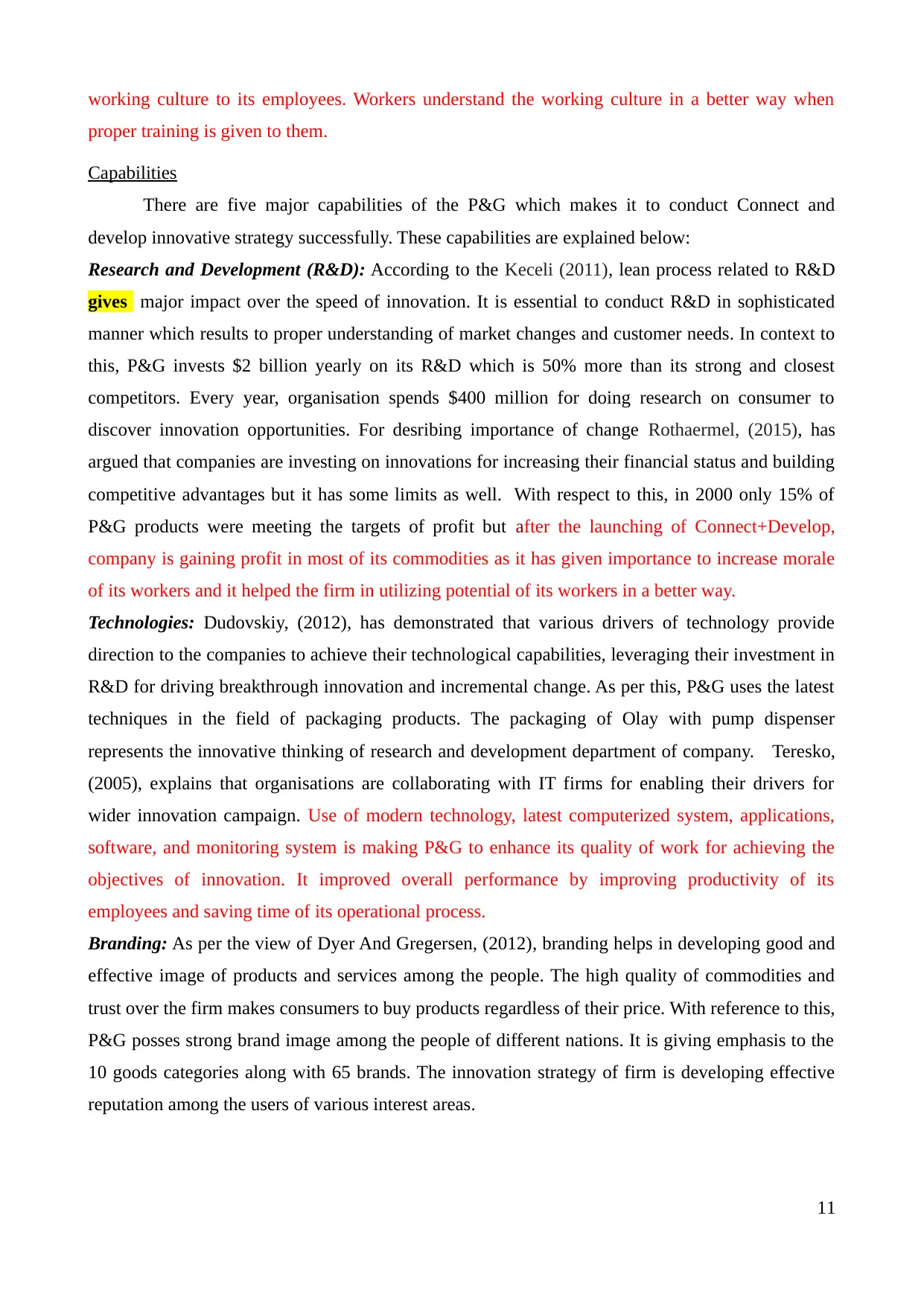
working culture to its employees. Workers understand the working culture in a better way when
proper training is given to them.
Capabilities
There are five major capabilities of the P&G which makes it to conduct Connect and
develop innovative strategy successfully. These capabilities are explained below:
Research and Development (R&D): According to the Keceli (2011), lean process related to R&D
gives major impact over the speed of innovation. It is essential to conduct R&D in sophisticated
manner which results to proper understanding of market changes and customer needs. In context to
this, P&G invests $2 billion yearly on its R&D which is 50% more than its strong and closest
competitors. Every year, organisation spends $400 million for doing research on consumer to
discover innovation opportunities. For desribing importance of change Rothaermel, (2015), has
argued that companies are investing on innovations for increasing their financial status and building
competitive advantages but it has some limits as well. With respect to this, in 2000 only 15% of
P&G products were meeting the targets of profit but after the launching of Connect+Develop,
company is gaining profit in most of its commodities as it has given importance to increase morale
of its workers and it helped the firm in utilizing potential of its workers in a better way.
Technologies: Dudovskiy, (2012), has demonstrated that various drivers of technology provide
direction to the companies to achieve their technological capabilities, leveraging their investment in
R&D for driving breakthrough innovation and incremental change. As per this, P&G uses the latest
techniques in the field of packaging products. The packaging of Olay with pump dispenser
represents the innovative thinking of research and development department of company. Teresko,
(2005), explains that organisations are collaborating with IT firms for enabling their drivers for
wider innovation campaign. Use of modern technology, latest computerized system, applications,
software, and monitoring system is making P&G to enhance its quality of work for achieving the
objectives of innovation. It improved overall performance by improving productivity of its
employees and saving time of its operational process.
Branding: As per the view of Dyer And Gregersen, (2012), branding helps in developing good and
effective image of products and services among the people. The high quality of commodities and
trust over the firm makes consumers to buy products regardless of their price. With reference to this,
P&G posses strong brand image among the people of different nations. It is giving emphasis to the
10 goods categories along with 65 brands. The innovation strategy of firm is developing effective
reputation among the users of various interest areas.
11
proper training is given to them.
Capabilities
There are five major capabilities of the P&G which makes it to conduct Connect and
develop innovative strategy successfully. These capabilities are explained below:
Research and Development (R&D): According to the Keceli (2011), lean process related to R&D
gives major impact over the speed of innovation. It is essential to conduct R&D in sophisticated
manner which results to proper understanding of market changes and customer needs. In context to
this, P&G invests $2 billion yearly on its R&D which is 50% more than its strong and closest
competitors. Every year, organisation spends $400 million for doing research on consumer to
discover innovation opportunities. For desribing importance of change Rothaermel, (2015), has
argued that companies are investing on innovations for increasing their financial status and building
competitive advantages but it has some limits as well. With respect to this, in 2000 only 15% of
P&G products were meeting the targets of profit but after the launching of Connect+Develop,
company is gaining profit in most of its commodities as it has given importance to increase morale
of its workers and it helped the firm in utilizing potential of its workers in a better way.
Technologies: Dudovskiy, (2012), has demonstrated that various drivers of technology provide
direction to the companies to achieve their technological capabilities, leveraging their investment in
R&D for driving breakthrough innovation and incremental change. As per this, P&G uses the latest
techniques in the field of packaging products. The packaging of Olay with pump dispenser
represents the innovative thinking of research and development department of company. Teresko,
(2005), explains that organisations are collaborating with IT firms for enabling their drivers for
wider innovation campaign. Use of modern technology, latest computerized system, applications,
software, and monitoring system is making P&G to enhance its quality of work for achieving the
objectives of innovation. It improved overall performance by improving productivity of its
employees and saving time of its operational process.
Branding: As per the view of Dyer And Gregersen, (2012), branding helps in developing good and
effective image of products and services among the people. The high quality of commodities and
trust over the firm makes consumers to buy products regardless of their price. With reference to this,
P&G posses strong brand image among the people of different nations. It is giving emphasis to the
10 goods categories along with 65 brands. The innovation strategy of firm is developing effective
reputation among the users of various interest areas.
11
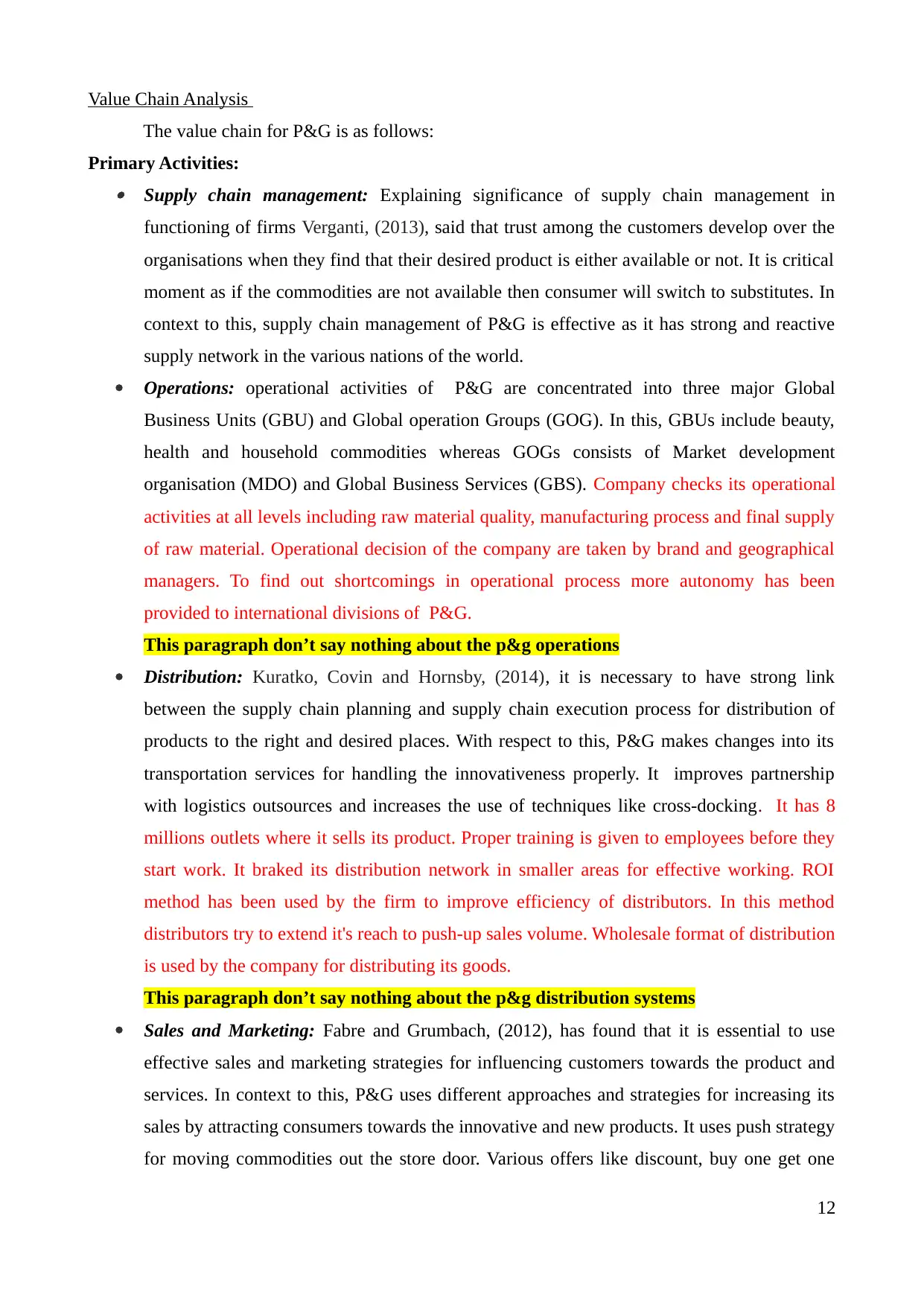
Value Chain Analysis
The value chain for P&G is as follows:
Primary Activities: Supply chain management: Explaining significance of supply chain management in
functioning of firms Verganti, (2013), said that trust among the customers develop over the
organisations when they find that their desired product is either available or not. It is critical
moment as if the commodities are not available then consumer will switch to substitutes. In
context to this, supply chain management of P&G is effective as it has strong and reactive
supply network in the various nations of the world.
Operations: operational activities of P&G are concentrated into three major Global
Business Units (GBU) and Global operation Groups (GOG). In this, GBUs include beauty,
health and household commodities whereas GOGs consists of Market development
organisation (MDO) and Global Business Services (GBS). Company checks its operational
activities at all levels including raw material quality, manufacturing process and final supply
of raw material. Operational decision of the company are taken by brand and geographical
managers. To find out shortcomings in operational process more autonomy has been
provided to international divisions of P&G.
This paragraph don’t say nothing about the p&g operations
Distribution: Kuratko, Covin and Hornsby, (2014), it is necessary to have strong link
between the supply chain planning and supply chain execution process for distribution of
products to the right and desired places. With respect to this, P&G makes changes into its
transportation services for handling the innovativeness properly. It improves partnership
with logistics outsources and increases the use of techniques like cross-docking. It has 8
millions outlets where it sells its product. Proper training is given to employees before they
start work. It braked its distribution network in smaller areas for effective working. ROI
method has been used by the firm to improve efficiency of distributors. In this method
distributors try to extend it's reach to push-up sales volume. Wholesale format of distribution
is used by the company for distributing its goods.
This paragraph don’t say nothing about the p&g distribution systems
Sales and Marketing: Fabre and Grumbach, (2012), has found that it is essential to use
effective sales and marketing strategies for influencing customers towards the product and
services. In context to this, P&G uses different approaches and strategies for increasing its
sales by attracting consumers towards the innovative and new products. It uses push strategy
for moving commodities out the store door. Various offers like discount, buy one get one
12
The value chain for P&G is as follows:
Primary Activities: Supply chain management: Explaining significance of supply chain management in
functioning of firms Verganti, (2013), said that trust among the customers develop over the
organisations when they find that their desired product is either available or not. It is critical
moment as if the commodities are not available then consumer will switch to substitutes. In
context to this, supply chain management of P&G is effective as it has strong and reactive
supply network in the various nations of the world.
Operations: operational activities of P&G are concentrated into three major Global
Business Units (GBU) and Global operation Groups (GOG). In this, GBUs include beauty,
health and household commodities whereas GOGs consists of Market development
organisation (MDO) and Global Business Services (GBS). Company checks its operational
activities at all levels including raw material quality, manufacturing process and final supply
of raw material. Operational decision of the company are taken by brand and geographical
managers. To find out shortcomings in operational process more autonomy has been
provided to international divisions of P&G.
This paragraph don’t say nothing about the p&g operations
Distribution: Kuratko, Covin and Hornsby, (2014), it is necessary to have strong link
between the supply chain planning and supply chain execution process for distribution of
products to the right and desired places. With respect to this, P&G makes changes into its
transportation services for handling the innovativeness properly. It improves partnership
with logistics outsources and increases the use of techniques like cross-docking. It has 8
millions outlets where it sells its product. Proper training is given to employees before they
start work. It braked its distribution network in smaller areas for effective working. ROI
method has been used by the firm to improve efficiency of distributors. In this method
distributors try to extend it's reach to push-up sales volume. Wholesale format of distribution
is used by the company for distributing its goods.
This paragraph don’t say nothing about the p&g distribution systems
Sales and Marketing: Fabre and Grumbach, (2012), has found that it is essential to use
effective sales and marketing strategies for influencing customers towards the product and
services. In context to this, P&G uses different approaches and strategies for increasing its
sales by attracting consumers towards the innovative and new products. It uses push strategy
for moving commodities out the store door. Various offers like discount, buy one get one
12
⊘ This is a preview!⊘
Do you want full access?
Subscribe today to unlock all pages.

Trusted by 1+ million students worldwide
1 out of 21
Related Documents
Your All-in-One AI-Powered Toolkit for Academic Success.
+13062052269
info@desklib.com
Available 24*7 on WhatsApp / Email
![[object Object]](/_next/static/media/star-bottom.7253800d.svg)
Unlock your academic potential
Copyright © 2020–2025 A2Z Services. All Rights Reserved. Developed and managed by ZUCOL.



